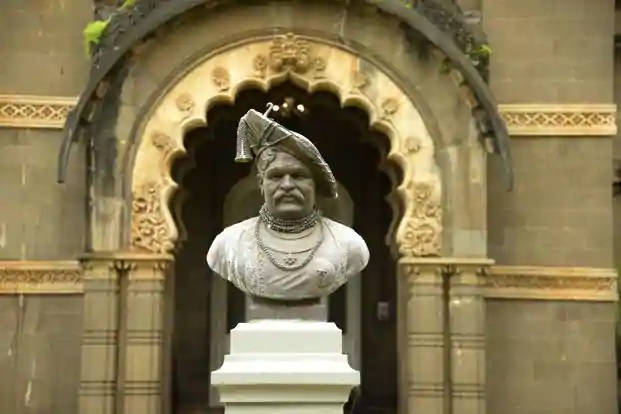
Nowadays, a 25-paise postage stamp sporting the face of Rajarshi Shahu Chhatrapati is hard to come by. However, in the instances it does, both collectors and Ambedkarites alike will recognise the personality as a leader who earnestly worked to uplift the Dalit communities in Kolhapur.
As per the first-issue citation of the stamp, Shahu was hailed as “a social revolutionary, a true democrat, a visionary, a patron of the theatre, music and sports.” True to these words, Shahu was first and foremost, an ally of the Dalit-Bahujan communities in his princely state, and supposedly the first king to declare affirmative action for socially-disadvantaged communities. May 6, marks his death anniversary after 47 years of commendable work as a reformer.
Although born as Yeshwantrao in the Ghatge Maratha family on June 26, 1874, the young Shahu was adopted by Queen Anandibai at the age of 10. This and the consequent influence of Jyotirao Phule inspired a desire to abolish caste segregation and untouchability.
Over the years, he worked to provide primary education to all, regardless of caste. In 1918, he wrote to the then Bombay Governor Lord Sydenham saying, “The principle that majorities have no need of separate representation doesn’t hold good in a province where a selfish minority [Brahmins and similar advantaged castes] is likely to get the power.”
He thus started various initiatives such as the Hostel movement to provide hostels for Panchals, Devadnya, Nabhik, Shimpi, Dhor-Chambhar communities as well as for Muslims, Jains and Christians. He also called for a moral and material progress scheme, announced free and compulsory education, encouraged female education and the establishment of libraries. On July 26, 1902, he also implemented 50 percent reservation for Dalit and other disadvantaged section of society. Moreover, he ensured employment for students following the completion of their education.
Among other things, the Rajarshi is most famously known for the Vedokta controversy. At the time, Brahmin priests of the Royal Religious advisors refused to perform rites for non-Brahmins in accordance with Vedic hymns. However, unwilling to give Brahmins a special status, Shahu removed the priests and appointed a young Maratha as the religious leader of non-Brahmins. He gave that person the title of Kshatra Jagadguru – the world teacher of Kshatriyas.
Although this earned much scorn from non-Dalit groups, Shahu went on to abrogate the archaic Balutdari system in 1917. It stated that an “Untouchable” and their family will work for the entire village without compensation in return for a small portion of land. Then, he declared a law in 1918 that abolished the economic slavery of Mahars under the oppressive Vatandari system and introduced land reforms to enable Mahars to become owners of land.
Another thing about Shahu Maharaj that appealed to Dalit communities was his affinity with Dr. Babasaheb Ambedkar. Artists Dattoba Pawar and Dittoba Dalvi introduced the two revolutionary leaders to each other. Their common goal to uplift oppressed communities inspired many such meetings between 1917–1921.
In 1920, they organised a conference wherein Shahu made Ambedkar the Chairman, believing that he would lead to the betterment of Dalits in India. As a token of this faith, he donated Rs. 2,500 for the other’s newly established ‘Mooknayak’ newspaper.
Other than such broad policies, he also established the Miss Clarke Boarding School for segregated groups and Vedic Schools allowing all to learn the scriptures and Sanskrit. As for adults, he started special schools for village heads to make for more competent administrators.
Under his rule, people were to treat each other as equal regardless of social status or caste. This meant that Dalits could use the same wells, ponds, hospitals as Brahmins. Inter-caste marriage was encouraged and revenue collectors became democratically-elected posts rather than hereditary titles. Further, he prepared gymnasiums and wrestling pitches to preserve the sport.
For women, he legalised widow remarriage, prohibited child marriage and called for a law banning the devadasi tradition wherein girls were offered to Gods as sacrifices and then sexually exploited by priests.
These and several such efforts in social, political, educational, agricultural and cultural dimensions of society inspired the title of Rajarshi (royal saint), bestowed upon him by the Kurmi warrior community of Kanpur. His achievements lost their lustre following his demise in the turmoil of national and regional politics. Nonetheless, sympathisers and supporters of Shahu and his beliefs continue his legacy even today.
Related:
Ambedkar and the call to Conversion!
Dalit trailblazer, Vira Sathidar succumbs to Covid-19
IIT Prof’s meltdown, abuse of students is a lesson on how not to teach
Supporting caste: A peek at the massive machine behind the enormous Maratha rallies
